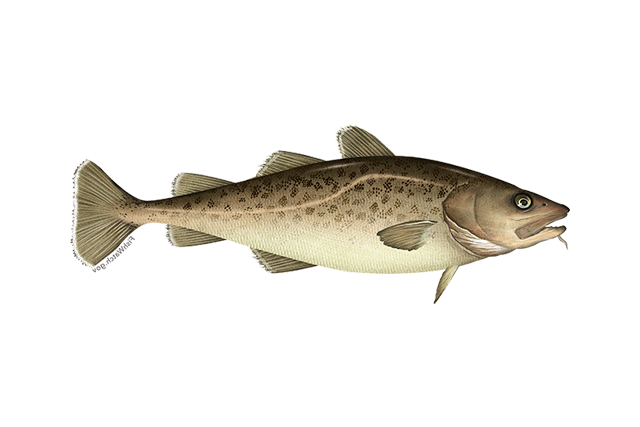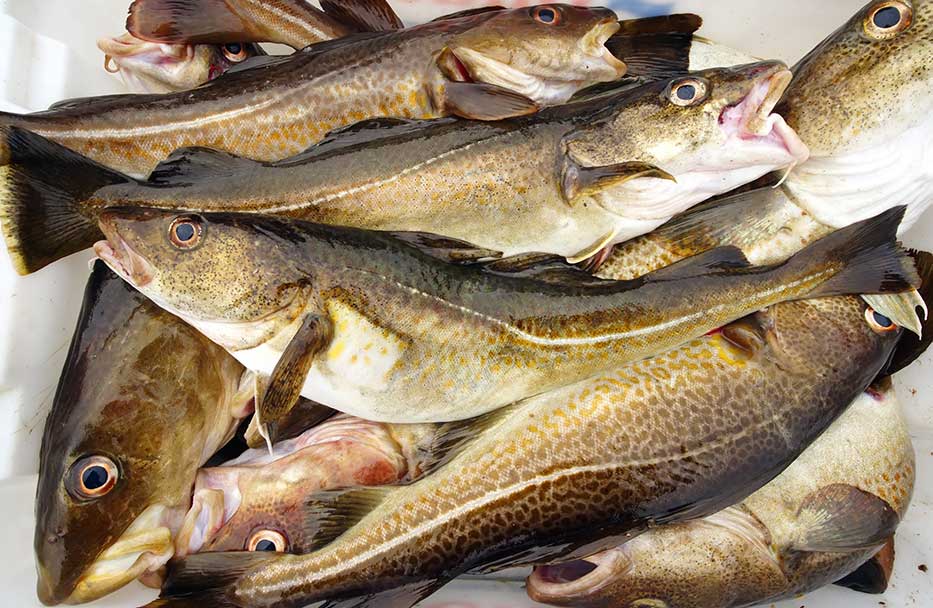| Weight | Up to 77 pounds |
| Lifespan | Up to 20 years |
| Length | Up to 51 inches |
| Threats: | Larger fish |
| Region: | North Pacific Ocean |

Cod
Gadus macrocephalus
Also Known As
Cod, Alaska cod, Gray cod, True cod
Facts
Nutrients
Serving Size: 1 fillet (231g)
| Calories: | 189 |
| Protein | 41g |
| Fat: | 1.5g |
| Saturated Fat: | 0.3g |
| Unsaturated Fat: | 0.5g |
| Total Carbohydrates: | 0g |
| Sodium: | 125g |
| Potassium: | 954mg |
| Cholesterol: | 99mg |

The Species
U.S. wild-caught Pacific cod is a smart seafood choice because it is sustainably managed and responsibly harvested under U.S. regulations.
Taste
Due to its white, delicate meat and mild flavor, cod is often called “the chicken of the sea,” and in many dishes it’s a delicious and versatile substitute for meat protein. Atlantic cod fillets tend to be firmer than Pacific cod fillets, though both practically fall apart into tender flakes of lean, white meat, melting in your mouth.
Status
- There are four stocks of Pacific cod: Bering Sea, Gulf of Alaska, Aleutian Islands, and West Coast:
- 2018 stock assessments in the Bering Sea and Gulf of Alaska indicate that Pacific cod are not overfished and not subject to overfishing.
- Although there was a 2018 stock assessment for the Aleutian Islands stock, data are insufficient to determine the population status at this time.
- The West Coast population of Pacific cod has never been formally assessed, but is not subject to overfishing based on 2016 catch data.
- In Alaska, scientists and managers determine the population status of Pacific cod based on estimates of spawning biomass—a measure of the number of females in the population that are able to reproduce.
- Estimated biomass has fluctuated over the past few decades; the stock increased rapidly, peaked in the 1980s, then declined slightly and stabilized.
Appearance
- Pacific cod are also known as gray cod because of their color—they’re brown or grayish with dark spots or patterns on the sides and a paler belly.
- They have a long chin barbell (a whisker-like organ near the mouth, like on a catfish) and dusky fins with white edges.
Biology
- Pacific cod live for 20 years or less.
- They can grow up to 6 feet in length.
- Females are able to reproduce when they’re 4 or 5 years old, when they are between 1.6 and 1.9 feet long.
- Pacific cod spawn from January to May on the continental shelf edge and upper slope in waters 330 to 820 feet deep.
- Females can produce more than 1 million eggs when they spawn.
- Pacific cod school together and move seasonally from deep outer and upper continental shelf areas (where they spawn) to shallow middle-upper continental shelf feeding grounds.
- They feed on clams, worms, crabs, shrimp, and juvenile fish.
Where They Live
- Pacific cod are found in the coastal North Pacific Ocean, from the Bering Sea to Southern California in the east and to the Sea of Japan in the west.
- They are less common in Central California and are rare in Southern California.
Source: NOAA Fisheries